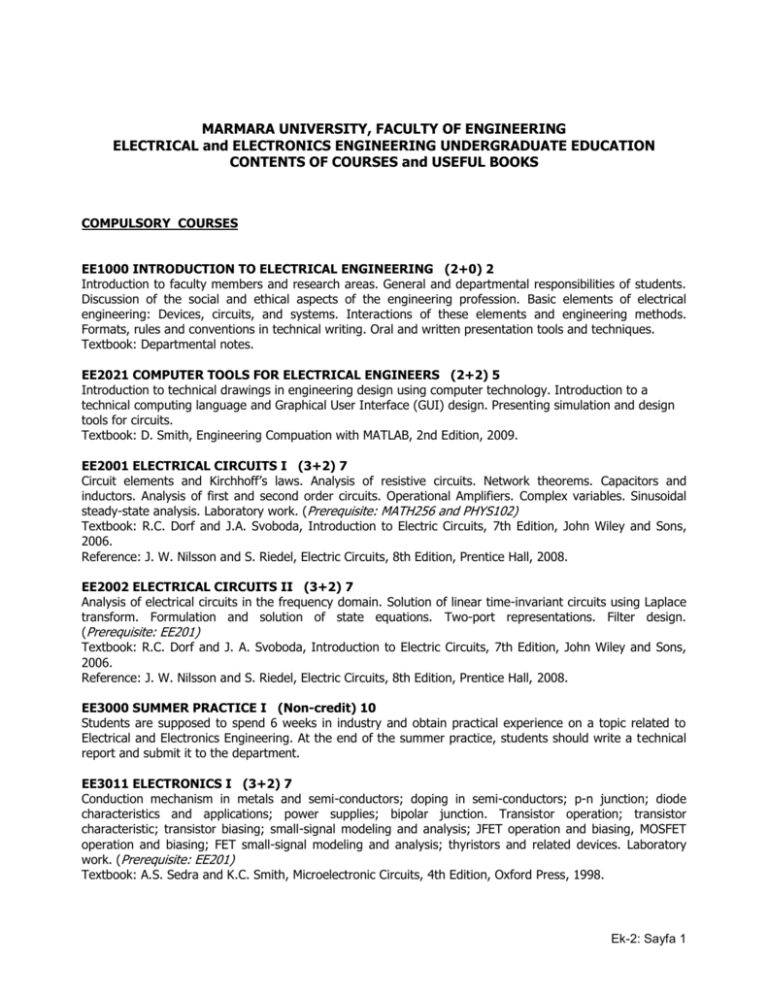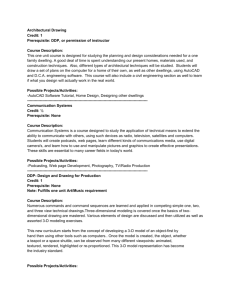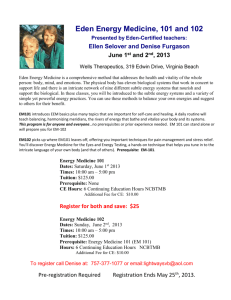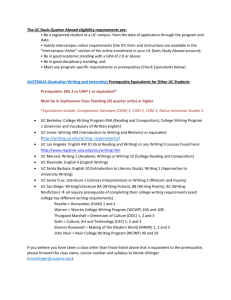Course Contents
advertisement

MARMARA UNIVERSITY, FACULTY OF ENGINEERING ELECTRICAL and ELECTRONICS ENGINEERING UNDERGRADUATE EDUCATION CONTENTS OF COURSES and USEFUL BOOKS COMPULSORY COURSES EE1000 INTRODUCTION TO ELECTRICAL ENGINEERING (2+0) 2 Introduction to faculty members and research areas. General and departmental responsibilities of students. Discussion of the social and ethical aspects of the engineering profession. Basic elements of electrical engineering: Devices, circuits, and systems. Interactions of these elements and engineering methods. Formats, rules and conventions in technical writing. Oral and written presentation tools and techniques. Textbook: Departmental notes. EE2021 COMPUTER TOOLS FOR ELECTRICAL ENGINEERS (2+2) 5 Introduction to technical drawings in engineering design using computer technology. Introduction to a technical computing language and Graphical User Interface (GUI) design. Presenting simulation and design tools for circuits. Textbook: D. Smith, Engineering Compuation with MATLAB, 2nd Edition, 2009. EE2001 ELECTRICAL CIRCUITS I (3+2) 7 Circuit elements and Kirchhoff’s laws. Analysis of resistive circuits. Network theorems. Capacitors and inductors. Analysis of first and second order circuits. Operational Amplifiers. Complex variables. Sinusoidal steady-state analysis. Laboratory work. (Prerequisite: MATH256 and PHYS102) Textbook: R.C. Dorf and J.A. Svoboda, Introduction to Electric Circuits, 7th Edition, John Wiley and Sons, 2006. Reference: J. W. Nilsson and S. Riedel, Electric Circuits, 8th Edition, Prentice Hall, 2008. EE2002 ELECTRICAL CIRCUITS II (3+2) 7 Analysis of electrical circuits in the frequency domain. Solution of linear time-invariant circuits using Laplace transform. Formulation and solution of state equations. Two-port representations. Filter design. (Prerequisite: EE201) Textbook: R.C. Dorf and J. A. Svoboda, Introduction to Electric Circuits, 7th Edition, John Wiley and Sons, 2006. Reference: J. W. Nilsson and S. Riedel, Electric Circuits, 8th Edition, Prentice Hall, 2008. EE3000 SUMMER PRACTICE I (Non-credit) 10 Students are supposed to spend 6 weeks in industry and obtain practical experience on a topic related to Electrical and Electronics Engineering. At the end of the summer practice, students should write a technical report and submit it to the department. EE3011 ELECTRONICS I (3+2) 7 Conduction mechanism in metals and semi-conductors; doping in semi-conductors; p-n junction; diode characteristics and applications; power supplies; bipolar junction. Transistor operation; transistor characteristic; transistor biasing; small-signal modeling and analysis; JFET operation and biasing, MOSFET operation and biasing; FET small-signal modeling and analysis; thyristors and related devices. Laboratory work. (Prerequisite: EE201) Textbook: A.S. Sedra and K.C. Smith, Microelectronic Circuits, 4th Edition, Oxford Press, 1998. Ek-2: Sayfa 1 EE3061 SIGNALS AND SYSTEMS (3+2) 7 Time and frequency domain analysis of signals and systems. Periodic signals. Fourier transforms. DFT. Convolution integral. Filters. Transmission of information by orthogonal functions. Modulation theory. Analysis of discrete time signals and systems. (Prerequisite: MATH255) Textbook: A. V. Oppenheim, A. S. Willsky, with S. H. Nawab, Signals and Systems, Prentice Hall, 2nd Edition, 1997. EE3012 ELECTRONICS II (3+2) 7 Multistage amplifiers; coupling techniques and frequency response; differential amplifiers; high-frequency modeling of transistors, feedback and broadbanding techniques. Analog Integrated Circuits; OpAmp; power amplifiers; filters and oscillators; regulated power supplies. (Prerequisite: EE311) Textbook: A.S. Sedra and K.C. Smith, Microelectronic Circuits, 4th Edition, Oxford Press, 1998. EE3051 FUNDAMENTALS OF ELECTROMAGNETICS (3+0) 6 Vector analysis for field theory. General principles. The static and magnetic fields. Electromagnetic energy, forces. Analytical and numerical techniques. Time varying electric and magnetic fields and Maxwell’s equations. (Prerequisite: MATH255) Textbook: D.K. Cheng, Fundamentals of Engineering Electromagnetics, Addison-Wesley Publishing Company, 1993. EE3072 SYSTEM DYNAMICS AND CONTROL (3+2) 7 Analysis of linear control systems by differential equations and transfer function methods using Laplace transforms. Stability of closed loop systems. Routh-Hurwitz criterion, root-locus diagrams. System analysis in frequency domain. Bode and polar plots. Nyquist stability criterion. Introduction to design and optimization of linear control systems, compensation techniques. (Prerequisite: EE361) Textbook: K. Ogata, Modern Control Engineering, Fourth Edition, Prentice-Hall, 2002. EE3082 COMMUNICATION ENGINEERING (3+2) 7 Building blocks of communication systems. Signal types, vector spaces, generalized functions. Hilbert transform and analytical signals. Linear and angular modulation methods, frequency division multiplexing. GM/SM applications, stereo TV. Sampling, quantization, PCM, DPCM, DM, TDM, pulse transmission: PAM,PDM PWM. Baseband data transmission: Nyquist pulse shaping; Bandpass data transmission and digital modulation techniques: ASK,PSK,FSK, QAM. (Prerequisite: EE361) Textbook: B.P. Lathi, Linear Systems and Signals, Prentice-Hall, 2000; B.P. Modern Digital and Analog Communication Systems, 3rd Edition, Oxford University Press, 1998. EE4000 SUMMER PRACTICE II (Non-credit) 10 Students are supposed to spend 6 weeks in industry and obtain practical experience on a topic related to Electrical and Electronics Engineering. At the end of the summer practice, students should write a technical report and submit it to the department. EE3042 ENERGY CONVERSION (3+0) 6 Energy technology and resources: Fossil fuels, nuclear, solar, and other types of energy. Three phase systems and magnetic circuits. Transformers: Ideal and physical models and equivalent circuit, and transformer testing. Electromechanical energy conversion. Efficiency and process performance. Sensors and actuators: Relays, stepper and positioning systems, switched reluctance machines, synchronous reluctance machines, direct current (DC) machines. Symmetrical alternating current (AC) synchronous machines. Symmetrical AC induction machines. (Prerequisite: EE201) Textbook: P.C. Sen, Principles of Electric Machines and Power Electronics, John Wiley, 1997. EE 4097 ENGINEERING PROJECT I (0+4) 11 A technical project emphasizing engineering design principles on a specific topic in any field of electrical and electronics engineering to be carried out by the senior student under the supervision of a faculty member. Involves design and implementation phases by applying a synthesis of knowledge and skills acquired in different courses during the undergraduate study. Ek-2: Sayfa 2 EE 4098 ENGINEERING PROJECT II (0+4) 11 Continuation of projects given in EE 497 with emphasis on realization of the design and implementation. The students are required to submit a written report summarizing the accomplishments of the project. Oral presentations and demonstration sessions on the completed projects are required as part of the course requirements. (Prerequisite: EE497) ELECTIVE TECHNICAL COURSES EE4011 ELECTRONIC MEASUREMENT AND INSTRUMENTATION TECHNIQUES (3+0) 5 Units and principles of measurement. Error of measurement. Probability of error. Electronic measurements and electronic measuring instruments: Instrument amplifiers, signal sources, oscilloscopes, digital frequency meters, digital voltmeters. High frequency and microwave measurement techniques. (Prerequisite: EE312) Textbook: A.D. Helfrick and W.D. Cooper, Modern Electronic Instrumentation and Measurement Techniques, Prentice-Hall, 1990. EE4012 DIGITAL ELECTRONICS (3+0) 5 Basic waveshapes and fundamentals of digital electronics. Principles of Metaloxide Semiconductor (MOS) transistor, operation of MOS inverters and gate curcuits (NMOS, CMOS). Principles of bipolar junction transistors (BJT), operation of BJT inverters and gate circuits (TTL, ECL, I2L), semiconductor memories. (Prerequisite: EE311) Textbook: D.A. Hodges, H.G. Jackson, Analysis and Design of Digital Integrated Circuits, 2nd Edition, McGraw-Hill Book Company, 1988. EE4013 COMMUNICATION ELECTRONICS (3+0) 5 Active and passive filters. Transistors. RF Amplifier analysis and synthesis using y-parameters. LC and crystal oscillators. PLL’s and frequency synthesizers. Linear and exponential modulator and demodulator design. (Prerequisite: EE312) Textbook: D.M. Pozar, Microwave and RF Design of Wireless Systems, John Wiley, 2001. EE4014 INDUSTRIAL ELECTRONICS (3+0) 5 Review of four layer devices and their applications. Gate control techniques in power switching elements and their protection. Introduction to solid-state energy conversion. AC/DC, AC/AC, DC/AC and DC/DC converters. Introduction to control of electrical drives. Industrial control systems: Relay circuits; ladder diagrams. Sequential control circuits. Case studies. (Prerequisite: EE312) Textbook: M. H. Rashid, Power Electronics: Circuits, Devices, and Applications, Prentice Hall, 1988. EE4015 OP-AMPS AND APPLICATIONS (3+0) 5 Op-Amp fundamentals; linear Op-Amp circuits: DC sources, current to voltage converters, voltage to current converters, current amplifiers, difference amplifiers, instrumentation amplifiers, transducer bridge amplifiers. Active filters; practical Op-Amp limitations; stability and frequency compensation. (Prerequisite: EE202) Textbook: S. Franco, Design with Operational Amplifiers and Analog Integrated Circuits, 3rd Edition, McGraw-Hill Book Company, 2002. EE4016 DESIGN WITH INTEGRATED CIRCUITS (3+0) 5 Nonlinear Circuit Applications: Voltage comparators, Schmitt triggers, precision rectifiers, analog switches, peak detectors, S/H circuits; signal generators: sine wave generators, multivibrators, IC timers, triangular wave generators, triangular-to-sine wave convertors, sawtooth wave generators, V/F and F/V convertors; DA and A-D convertors: Basic DAC techniques, Bipolar DAC's, high resolution DAC's,DAC-based AD conversion, parallel A-D techniques, Integrating Type ADC's; logarithmic amplifiers: Log/Antilog amplifiers; Phase-Locked Loops. (Prerequisite: CSE315) Textbook: S. Franco, Design with Operational Amplifiers and Analog Integrated Circuits, 3rd Edition, McGraw-Hill Book Company, 2002. EE4017 ELECTRICAL EQUIPMENT AND APPLICATIONS (3+0) 5 Ek-2: Sayfa 3 Introduction to power supplies and systems. Short circuit phenomena and analysis in low voltage systems. Protection concept, devices and applications in electrical systems. Characteristics and applications of circuit breakers, relays and fuses. Power and installation cables and applications. Power and energy measurement techniques and devices. Reactive power compensation. Battery plants and UPS systems. Lighting sources and installations. Electrical safety and earthing systems. (Prerequisite: EE201) Textbook: W. F. Kussy and J. L. Warren, Design Fundamentals for Low-Voltage Distribution and Control, Marcel Dekker Inc., 1986. EE4037 MICROCONTROLLER BASED SYSTEM DESİGN (3+0) 5 Elements of microcontroller systems, hardware and software analysis. Memory structure, addressing techniques, registers, instruction set, branching, stack, subroutines, interrupts and input-output devices in microcontrollers. Design of small microcontroller systems using assembly and C programming. (Prerequisite: CSE315) Textbook: M68HC12 Microcontrollers, MC68HC912D60A Advance Information, 4th Revision, FreeScale Semiconductor Inc. 2003. EE4042 UTILIZATION OF ELECTRICAL ENERGY (3+0) 5 Basic operating characteristics and classification of electrical drives. Solid state DC motor control. Solid state AC motor control. Dynamic behavior of electrical machines. Electric braking. Starting of electrical machines. Intermittent loads. Drive applications. Modern methods of reactive power compensation. Electrical energy saving. (Prerequisite: EE202) Textbook: N.V. Suryanarayana, Utilization of Electric Power including Electric Drives and Electric Traction, New Age International Limited Publishers, 1994. EE 4043 STATIC POWER CONVERSION (3+0) 5 Power switches and their characteristics. Power converter definitions, classification. VTA method. Midpoint and bridge rectifiers: non-ideal commutation, harmonics, input power factor, utility-factor, winding utilization and unbalances in rectifier transformers. Applications. (Prerequisite: EE312) Textbook: C.W. Lander, “Power Electronics”, Mc Graw Hill, 1987. EE4044 POWER SYSTEM ANALYSIS I (3+0) 5 Basic structure of electrical power systems. Electrical characteristics of transmission lines, transformers and generators. Representation of power systems. Per Unit System. Symmetrical three-phase faults. Symmetrical components. Unsymmetrical faults. (Prerequisite: EE201) Textbook: H. Saadat, Power System Analysis, 2nd Edition, McGraw-Hill Higher Education, 2002. EE4045 POWER SYSTEM ANALYSIS II (3+0) 5 Matrix analysis of power systems networks and methods of solution. Load flow and short circuit analysis. Economic operation of power systems. Transient stability analysis. (Prerequisite: EE444) Textbook: H. Saadat, Power System Analysis, 2nd Edition, McGraw-Hill Higher Education, 2002. Reference: A.-A. Fouad and V. Vittal, Power System Transient Stability Analysis Using the Transient Energy Function Method, Prentice-Hall Inc., 1992. EE4046 ELECTRICAL DISTRIBUTION SYSTEMS (3+0) 5 Basic considerations. Load characteristics and forecasting methods. Distribution substations. Subtransmission, primary and secondary distribution. Choice of voltage levels. Operational characteristics of cables, aerial lines and transformers. System voltage regulation. Power factor correction. Fusegear, switchgear, current and voltage transformers. Overcurrent and thermal protection. Earthing methods. Economics of distribution systems. (Prerequisite: EE201) Textbook: A.S. Pabla, Electric Power Distribution, McGraw-Hill Companies Inc., 2005. EE4047 HIGH VOLTAGE TECHNIQUES I (3+0) 5 Field analysis: experimental and numerical (finite difference, finite element and charge simulation) methods and applications. Electrical breakdown in gases: ionization processes. Townsend's breakdown criterion, Paschen's Law, bread-down in electronegative gases, time lags. Streamer-Kanal mechanism, breakdown in non-uniform field and corona. Electrical break-down of liquids: breakdown mechanism of pure and Ek-2: Sayfa 4 commercial liquids. Electrical breakdown of solids: intrinsic, electromechanical, thermal and erosion mechanism. Insulating materials: dielectric gases; insulating oils and solid dielectrics. (Prerequisite: EE201) Textbook: J. Kuffel, E. Kuffel and W.S. Zaengl, High Voltage Engineering Fundamentals, 2nd Edition, Butterworth-Heinemann, 2000. EE4048 HIGH VOLTAGE TECHNIQUES II (3+0) 5 Generation and measurement of high AC, DC and impulse voltages and impulse currents: AC to DC conversion and electrostatic generators. Testing transformers and series resonant circuits. Impulse voltage generator circuits. Operation, design and construction of impulse generators. Impulse current generator circuits. Sphere and uniform fieldgaps. Electrostatic, generating and peak voltage measuring voltmeters. Voltage dividers. Measurement of impulse voltages and currents. Dielectric measurements. (Prerequisite: EE447) Textbook: J. Kuffel, E. Kuffel and W.S. Zaengl, High Voltage Engineering Fundamentals, 2nd Edition, Butterworth-Heinemann, 2000. EE4049 POWER SYSTEM PROTECTION (3+0) 5 Current and voltage transformers. Overcurrent protection. Comparators and static relay circuits. Differential protection and its application to generators, transformers and bus bars. Motor protection. Pilot wire protection of feeders. Introduction to distance and other protection systems. (Prerequisite: EE201) Textbook: P.M. Anderson, Power System Protection, The Institute of Electrical and Electronics Engineering, Inc., 1999. EE4051 ELECTROMAGNETIC WAVES (3+0) 5 Maxwell's equations in time and frequency domains. Electromagnetic energy and power. Wave equation. Uniform plane electromagnetic waves; reflection and refraction. Introduction to transmission lines, waveguides, antennas and radiation. (Prerequisite: EE352) Textbook: U.S. Inan and A.S. Inan, Electromagnetic Waves, Barnes and Noble, 1999. EE4052 ANTENNAS AND PROPAGATION (3+0) 5 Antenna parameters. Linear antennas. Influence of earth on antenna radiation pattern and impedance. Radiation from slot and aperture antennas. Antenna arrays and the general array formula. Baluns. Receiving antenna theory. Elements of groundwave, tropospheric and ionospheric propagation. (Prerequisite: EE352) Textbook: C. A. Balanis, Antenna Theory: Analysis and Design, 3rd Edition, John Wiley & Sons, 2005. EE4053 MICROWAVES (3+0) 5 TEM mode transmission lines. Field and distributed circuit analysis. Frequency and time domain analysis. Waveguiding structures. Rectangular and circular waveguides. Impedance transformations and matching techniques. Scattering matrix of microwave junctions. (Prerequisite: EE352) Textbook: S.A. Maas, Nonlinear Microwave and RF Circuits, 2nd Edition, Artech House, Inc., 2003. EE 4061 INTRODUCTION TO DIGITAL SIGNAL PROCESSING (3+0) 5 Sampling and quantization schemes. Linear shift invariant systems, stability and causality. Two-dimensional systems and sequences. Flow graphs, digital filter design techniques, FIR and IIR filters. Computation of DFT, FFT techniques. Effects of finite register length. Estimation of power spectra. Homomorphic filtering, discrete-time random signals and systems. (Prerequisite: EE361) Textbook: J.G. Proakis and D. Manolakis, Digital Signal Processing, 3rd Edition, Prentice Hall, 1996. EE4062 INTRODUCTION TO IMAGE PROCESSING (3+0) 5 Digital images. Sampling and quantization of images. Color, stereo and video images. Arithmetic operations, gray scale manipulations, distance measures, connectivity. Image transforms. Linear and nonlinear filters. Image enhancement. Image restoration: degradation models, inverse filtering. Image segmentation. Image representation and description techniques. (Prerequisite: EE361) Textbook: R.C.Gonzalez and R.E.Woods, Digital Image Processing, Addison-Wesley, 2001. EE4071 LINEAR SYSTEM THEORY (3+0) 5 Ek-2: Sayfa 5 Introduction to realization theory for single-input, single-output (SISO) systems. Solution of the state space equations. Structural properties: controllability, observability, detectability, stabilizability. State feedback design, observer design and design of observer-based compensators for SISO systems. (Prerequisite: EE372) Textbook: T. Kailath, Linear Systems, Prentice-Hall, 2000. EE4072 CONTROL TECHNOLOGY AND DESIGN (3+0) 5 An overview of design techniques with particular interest to industrial requirements. Fedback implementation: transducers, sensors, and signal conditioning. Implementation of various types of control actions and servo control. Laboratory. (Prerequisite: EE372) Textbook: R. Bateson, Introduction to Control System Technology, 7th Edition, Prentice Hall, 2002. EE4073 INTRODUCTION TO OPTIMIZATION THEORY (3+0) 5 Unimodal search, unconstrained optimization with respect to a single variable, optimization with respect to a multiple variables, constrained optimization, calculus of variations, principles of optimality and dynamic programming, maximum principle, Kuhn-Tucker conditions of optimality. (Prerequisite: EE372) Textbook: E.K. P. Chong and S.H. Zak, An Introduction to Optimization, 2nd Edition, Wiley, 2001. EE4074 DISCRETE TIME SYSTEMS (3+0) 5 Importance and advantages of discrete-time system models in control. Time domain analysis of discretetime systems. Sampled data systems. Stability; translation of analog design. State space design methods: observer theory, introduction to optimal design methods. Quantization effects. (Prerequisite: EE372) Textbook: K. Ogata, Discrete-Time Control Systems, 2nd Edition, Prentice Hall, 1995. EE 4075 NONLINEAR CONTROL SYSTEMS (3+0) 5 State-space analysis methods. Isocline Lienard's methods, classification of singularities. Analytic techniques of periodic phenomena: perturbation method. Stability definitions. Lyapunov's second method; Popov stability criterion. The method of harmonic realization: describing functions. Dual-input describing functions. Equivalent linearization and oscillations in nonlinear feedback systems. (Prerequisite: EE372) Textbook: H. Marquez, Nonlinear Control Systems: Analysis and Design, Barnes and Noble, 2003. EE4076 PROCESS CONTROL (3+0) 5 Control of industrial processes: mathematical modeling of fundamental distributed parameter processes. Lumped parameter approximation. Disturbance filtering characteristics of control loops. Proportional, integral, derivative, on-off, floating modes of controls, feedforward and cascade types of loops. Minimization of integral square error. Characteristics of flow, pressure and level control loops and final control elements. Fundamentals of control of basic processes such as heat exchange, distillation, combustion, drying. Organization of direct digital control loops. (Prerequisite: EE372) Textbook: J. Stenerson, Industrial Automation and Process Control, Barnes and Noble, 2002. EE4081 INTRODUCTION TO INFORMATION THEORY (3+0) 5 Information content, conditional, joint and mutual entropy. Binary symmetric channels;channels with and without memory. Source coding algorithms and rate-distortion bounds. Channel capacity and Shannon law. Block code, cyclic codes, convolution codes. (Prerequisite: EE361) Textbook: Jan C. A. van der Lubbe, Information Theory, Cambridge Universty Press, 1997. EE 4082 DIGITAL COMMUNICATION (3+0) 5 Stochastic processes. Noise analysis in analog communication. Data transmission through AWGN channel, bandpass data transmission, equalization. Optimum receiver design, carrier and pulse synchronization. Error probabilities for binary/m-ary transmission. Carrier modulation : CAM, CPM, CFM, QAM and their performances. Entropy, quantization and rate distortion, information sources, channel capacity, coding. (Prerequisite: EE382) Textbook: S. Haykin, Communication Systems, 4th Edition, John Wiley & Sons Inc., 2001. EE 4083 MOBILE COMMUNICATION (3+0) 5 Ek-2: Sayfa 6 VHF and UHF communication in land-mobile communication. Channel characterization; fast and slow fading, frequency selectivity, delay and spread coherence bandwidth. Signal loss probability. Interference environments and its control. Frequency control. Diversity techniques for digital land mobile radio. Spatial distribution of offered traffic. Efficient spectral utilization. Capacity calculations and networking. (Prerequisite: EE382) Textbook: T. S. Rappaport, Wireless Communications: Principles and Practice, Upper Saddle River, New Jersey: Prentice-Hall, 2002. EE 4091 SPECIAL TOPICS IN ELECTRICAL AND ELECTRONICS ENGINEERING (3+0) 5 These code number will be used for a course which is not listed regularly in the catalog. The course content will be announced before the semester commences. EE 4014 VLSI CIRCUIT DESIGN (3+0) 5 Size and complexity of integrated circuits (IC), IC design process, trends in very large scale integrated (VLSI) circuit design, IC production process, semiconductor processes, design rules and process parameters, layout techniques and practical considerations, device modeling, circuit simulation, basic integrated circuit building blocks. CSE 4053 INFORMATION SYSTEMS: ANALYSIS AND DESIGN (3+0) 5 Information systems: characteristics, components, applications, business and organizational systems, requirement analysis, design, implementation, testing, operation and maintenance, prototyping. Information system technology: CASE tools, database management systems, data communication, networking, distributed business systems, Hardware and software selection. CSE 4056 MANAGEMENT of INFORMATION SYSTEMS (3+0) 5 Decision making process, planning and control, organizational structure, management concepts, information-based support systems, support systems for planning, control and decision making, strategies for determination of information requirements, organization and management of information resources function, management information systems (MIS), organizational and social implications of MIS. CSE 4071 FUNDAMENTALS PRINCIPLES OF PROGRAMMING LANGUAGES (3+0) 5 Syntax and semantics of programming languages, grammars, design of programming languages, data types, variables, expressions and statements, procedures, recursion, parameter passing, dynamic and static memory management. Comparative study of functional, logic and object-oriented programming languages. CSE 4073 INTRODUCTION to COMPUTER NETWORKS (3+0) 5 Basic concepts of data transmission. Overview of network layers and network architectures. ISO-OSI reference model. Physical layer and data communication issues. Circuit switching, packet switching. Network topology. Data link layer and its protocols, error-detection and correction. Local area networks, Ethernet, bridges and switches. Network layer issues and protocols, routing algorithms, congestion control, Internet Protocol. Transport layer and internet transport protocols (TCP and UDP). Network applications and programming: the socket interface, DNS, SMTP, FTP, and WWW. CSE 4072 MACHINE LEARNING (3+0) 5 Paradigms and issues of machine learning. Supervised and unsupervised learning. Statistical models. Learning decision trees. Clustering. Feature extraction. Artificial neural networks. Reinforcement learning. Applications of machine learning. OTHER COMPULSORY COURSES CHEM 1007 BASIC CHEMISTRY (4+0) 6 The atom, chemical bond, molecular geometry, stoichiometry, thermochemistry, states of matter, solids, gaseous state, liquid state, mixtures. Chemical kinetics, chemical equilibrium, solubility equilibria in aqueous Ek-2: Sayfa 7 solutions, acids and basis, thermodynamics, oxidation-reduction and electrochemistry, nuclear chemistry, chemistry of the environment. MATH 1001 CALCULUS I (4+0) 6 Rate of change of a function, formal differentiation, applications of derivative, the integral, applications of the definite integral, transcendental functions, techniques of integration. PHYS 1001 PHYSICS I (4+0) 5 Measurement, vectors, motion in one dimension, motion in a plane, Newton’s laws, friction and forces in circular motion, work and energy, conservation of energy and linear momentum, impulse and collisions, rotational kinematics and dynamics, conservation of angular momentum, equilibrium of rigid bodies. CSE 1045 INTRODUCTION TO COMPUTER PROGRAMMING (3+2) 6 An introduction to the process of program design and analysis for students who have no prior programming experience. Topics to be covered include basic data types and their operators, expressions and assignment statements, I/O, control structures (selection, loops), classes (including methods and fields), arrays, functions and procedures, files. ATA 121 ATATURK’S PRINCIPLES AND THE HISTORY OF TURKISH RENOVATION I (2+0) 2 The Principles of Atatürk and The History of Turkish Revolution Course is a core course as in all other higher education institutions in Turkey. The course includes the strategy of Turkish revolution, general status of Europe in the period when Kemalism as a way of thinking began to mature, Imperialism, Industrial Revolution, the structure of Ottoman Empire, the effects of First World War on Ottoman Empire, and the historical period from Mondros to Sevr and Lozan. TRD 121 TURKISH LANGUAGE I (2+0) 2 Turkish Language as a core course aims to make the students learn the structural and operational properties of their native language and to make them gain the ability of using Turkish correctly and also aims to make an integrative and unifying language dominate the education. This course includes the subjects of languages in the world, languages with respect to their structures and resources, the position of Turkish among other languages and basics of Turkish grammar. MATH 1002 CALCULUS II (4+0) 6 Plane analytic geometry, hyperbolic functions, vectors and parametric equations, vector functions and their derivatives, partial differentiation, multiple integrals, vector analysis, infinite series. (Prerequisite: MATH101) MATH 2056 LINEAR ALGEBRA (3+0) 4 Systems of linear equations, matrix algebra, special types of matrices, determinants, Cramer’s rule, vector spaces, subspaces, linear independence, basis and dimension, row space and column space, linear transformations, similarity, scalar product, orthogonal and inner product subspaces, orthonormal sets, the Gram-Schmidt orthogonalization process, eigenvalues and eigenvectors, systems of linear differential equations, diagonalization. (Prerequisite: MATH101) PHYS 1002 PHYSICS II (4+0) 5 Coulomb’s law, electric field, gauss’s law, electric potential, capacitors and dielectrics, ohm’s law, emf, magnetic field, Ampere’s law, Faraday’s law, inductance, magnetic properties of matter, electromagnetic oscillations, alternating currents. PHYS 1004 PHYSICS LAB (0+2) 3 Physics experiments related to topics covered in PHYS 101 and 102. CSE 1046 INTERMEDIATE PROGRAMMING (3+2) 6 Programming methodology: specification, design, coding and program correctness. Review of data types (scalar and structured types), procedures and functions, recursion, files (sequential and random access), arrays, character strings and records. Basic data structures and their implementations: linear structures Ek-2: Sayfa 8 (linked lists, stacks and queues) and nonlinear structures (trees and sets). Exercises in a structured or an object-oriented programming language. (Prerequisite: CSE141) ATA 122 ATATURK’S PRINCIPLES AND THE HISTORY OF TURKISH RENOVATION II (2+0) 2 This course is a continuation of History 111 and includes the establishment of Turkish Republic on the ruins of Ottoman Empire, the modernization of Turkish Republic, the principles of Atatürk, ideology of Kemalism, ideologies of modernization, other ideologies in the world, economic models, and the differences between Kemalism and other ideologies. (Prerequisite: ATA121) TRD 122 TURKISH LANGUAGE II (2+0) 2 This course is a continuation of TRD 121 and includes general topics in writing skills, reporting techniques and information about Atatürk and Turkish language besides the properties of Turkish language. (Prerequisite: TRD121) MATH 2055 DIFFERENTIAL EQUATIONS (3+0) 4 Classification and origin of differential equations, initial and boundary value problems, first order differential equations having exact solutions, explicit methods of solving higher-order linear differential equations, differential equations with variable coefficients, applications of first and second order differential equations, series solutions and systems of linear differential equations, Laplace Transforms. (Prerequisite: MATH102) MSE2072 INTRODUCTION TO MATERIALS SCIENCE (3+0) 4 Atomic structure and bonding, structure of solids, defects and imperfections, rate processes and crystallization, phase transformations and equilibria, interfacial phenomena, mechanical properties, electrical properties, metals, ceramics, polymers. (Prerequisite: CHEM107) MATH 2057 DISCRETE MATHEMATICS (3+0) 5 Propositions and mathematical logic, theorem proving, set theory, finite-infinite sets, mathematical induction, relations, recurrence relations, properties of relations, graphs, multigraphs, directed graphs, counting techniques, eulerian paths, hamiltonian paths, circuits, trees, binary search trees, spanning trees, recurrence relations, groups and rings. MATH 2059 NUMERICAL METHODS (3+0) 4 Computational and mathematical preliminaries, one variable equations, interpolation and approximation, direct and iterative solution of linear equation systems, numerical eigenvalue and eigenvector computations, numerical integration and differentiation, solution of nonlinear equation systems, numerical solution of first order differential equations. (Prerequisite: MATH102) STAT 2056 PROBABILITY AND RANDOM VARIABLES (3+0) 4 Collection, organization and presentation of data. Introduction to probability theory, counting theorems, conditional probability and independence. Random variables, expectation, discrete probability models, continuous probability models, normal distribution and related distributions, central limit theorem. Point and interval estimation, testing statistical hypotheses. Regression and correlation analysis. (Prerequisite: MATH101) CSE 2037 INTRODUCTİON TO SYSTEMS PROGRAMMING (2+2) 7 The course content includes two main parts. First part introduces computer hardware and software, addressing methods, instruction sets and formats and details of assembly language programming. Overview of compilers, interpreters, assemblers, linkers and loaders are given as part of the course. The second part introduces UNIX environment by including shell programming, UNIX system calls and signals, UNIX programming and multithreading. Programming assignments are given on both assembly language and UNIX/Linux environment. (Prerequisite: CSE142) Ek-2: Sayfa 9 CSE 3017 DIGITAL DESIGN (3+2) 6 Number systems, Boolean algebra and functions, logic gates. Analysis and design of combinational circuits. Combinational MSI components. Flip-flops, counters and shift registers. Analysis and design of sequential circuits. State table, state minimization and state assignment. Sequential MSI components. Register transfer and micro-operations. Basic computer organization and design: arithmetic logic, memory and control units. Laboratory experiments and applications of digital logic design. CSE 2062 OBJECT-ORIENTED PROGRAMMING (3+0) 6 Software quality, object-oriented approach, dynamic objects, genericity and parameterizing classes, assertions, preconditions and postconditions, class invariants and class correctness, exceptions handling, inheritance, polymorphism, deferred classes, multiple inheritance, persistent objects and classes, operations on persistent objects, object oriented databases, object oriented analysis and design, object oriented languages. (Prerequisite: CSE142) ECON 2003 INTRODUCTION TO ECONOMICS (3+0) 4 Introductory economics, scope of economics, consumer theory, production and cost theory, demand and supply analysis, factor markets, different market forms, circular flow, fluctuations in economics activity, multiplier and accelerator analysis, demand for and supply of money, inflation and unemployment. ECON 2004 ENGINEERING ECONOMY (2+0) 4 Cash flows and discounting, special cash flows, taxes and depreciation, effects of inflation, decision criteria, decision processes, sensitivity and break-even analysis, matrix decision models, expected value decision making, utility theory. LAW 2003 BUSINESS LAW AND ETHICS (3+0) 4 Sources of Turkish Private law, the concept of systems of law, scope of the civil code, sources of obligations, definition of obligations, Turkish law of obligations; special obligations driving from contracts, from illegal acts and from unjustifiable enrichment. Business ethics. NON-TECHNICAL ELECTIVE COURSES YDA 1001 GERMAN FOR BEGINNERS (2+0) 3 Basic German grammar and language for beginners. YDA 1002 GERMAN (2+0) 3 One semester intensive course in basic German, providing students to develop their German. Emphasis is placed on fundamental drills in structure (Grammar) writing, vocabulary, comprehension and pronunciation through the use of controlled texts and programmed material. YDA 1003 GERMAN COMMUNICATION (2+0) 3 This is an advanced level German course aimed at consolidation of previously learned skills and expanding into new areas using controlled texts. Reading texts focus on separate academic disciplines such as physchology, physics, business, literature, engineering and political science. Writing skills are further developed into essay writing, emphasis is given to thesis statement. YDA 2001 SEMINARS IN GERMAN (2+0) 3 An advanced German course aimed at bridging the gap between minimal and college - level academic German. Emphasis is based on using library and reference skills, writing academic papers, and presentation of papers as lectures in class students are also taught how to write formal C.V. (Resume) and application letters. HR 1013 CAREER DEVELOPMENT (2+0) 3 The learning process. Science, engineering and technology. Elements of engineering education. The engineering profession and career development. Engineering design: decision making, modeling and Ek-2: Sayfa 10 systems. Information research methods. Communications and technical writing. Teamwork. Oral presentation skills. CAS 3001 EARTHQUAKE AND RESCUE PRINCIPLES (2+0) 3 Definition of earthquake properties. Structural damage caused by earthquakes. Rescue team’s properties. Equipment used by rescue teams. Rescue methods of disasters. Comparison of rescue methods. Case studies. General principles on rescue management. HSS 3002 ETHICS IN ENGINEERING AND SCIENCE (2+0) 3 Engineering history. Concepts of ethics in philosophy. Engineering ethics. Ethic norms. Ethic rules in investigation and engineering reports. Responsibility of engineer regarding law. Errors in engineering practice. Case studies. OB 3043 ORGANIZATIONAL BEHAVIOUR (2+0) 3 Definition of organizational behavior, perception, motivation and theories of motivation, learning and reinforcement, groups, theories of leadership, communication, conflict and negotiation, change in organizations, stress and time management. HR 401 CAREER ORIENTATION (2+0) 3 Theory of the needs, wants and demands. Career planning versus job finding, self assessment and behavioral profiles. Decision making: specialization versus versatility. Environmental trends, opportunities and requirements. Action planning: Related tools, resources, people and approaches. Uncertainties, barriers, accidents, crises and misfortunes, follow-up and re-assessment. Ek-2: Sayfa 11






